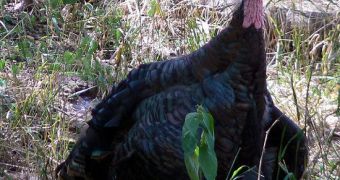In a new scientific study, researchers propose that the earliest winged dinosaurs ran and flew in pretty much the same way as certain species of modern turkeys do.
The scientists believe that primitive birds and proto-bird dinosaurs alike shared a lot of traits in common with precocious brush turkeys such as the ones currently living the Indo-Pacific.
These modern birds can fly the very same day they hatch, but they generally prefer not to do so. Rather, the wings are used for extra push when the animals want to run up a steep climb.
Experts behind the new study believe that early winged dinosaurs may have used their own wings and feathers in a similar manner, and that this habit eventually led to the development of stronger wings, muscles and other bodily modifications.
In order to test their idea, researchers Kenneth Dial and Brandon Jackson devised a series of experiments involving the turkeys. They constructed a series of sloped surfaces, and then captured the birds to investigate their behavior.
The slopes ranged from mild to being inclined towards the birds. The team was surprised to learn that hatchlings were a lot more capable than their parents to escalate all of the obstacles.
The older turkeys are a lot bulkier, and they no longer rely on their wings to help them get through bad situation. They use their feet instead, which have a lot of muscle, and are capable of carrying them faster than any predator can run.
But young hatchlings, on the other side, cannot do the same, and they need to employ evasive maneuvers. This is why they can run on vertical walls, which is a very useful trait in the wild.
“The hatchlings are very comfortable with these extraordinary slopes, with no panting or stress, doing it over and over and over again,” says Dial, who holds an appointment as an experimental functional morphologist at the University of Montana in Missoula.
“You can imagine they're preyed upon quite intensely, and do so to get to a refuge in the trees and cliffs and gullies where they live,” the expert adds for LiveScience.
“The adults are much more invested in their legs to build and maintain these enormous earthen mounds where they have their nests,” Dial adds.
The scientist adds that these birds may in fact be providing a clear indication of how the earliest winged dinosaurs and proto-birds lived and looked like.
“Proto-birds or dinosaurs that led to birds might have used these little winglike structures when small to lift themselves up, and as they got older, these limbs might have been used to help run or just been vestigial. The brush turkey could be a living model of how dinosaurs led to birds,” Dial concludes.
The two investigators published details of their study in the November 3 online issue of the esteemed journal Proceedings of the Royal Society B.

 14 DAY TRIAL //
14 DAY TRIAL //